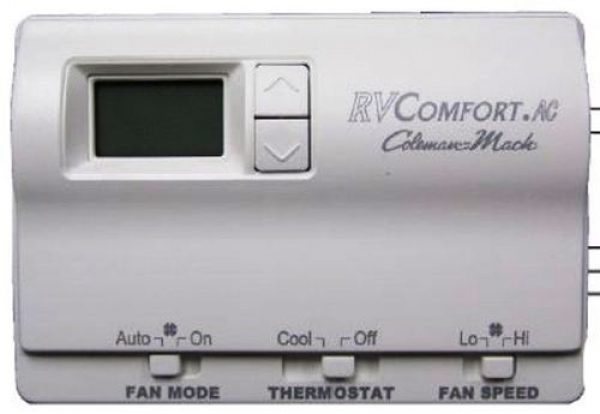Welcome to Crossing Creeks RV Resort & Spa in the heart of iconic Blairsville
Coming home to—or waking up to—a comfortable RV is fairly easy to accomplish, and quite affordable. All it takes is a digital, programmable thermostat. Let’s face it: If you can program your coffeemaker to percolate before you’re out of bed, you ought to be able to program your heating and air-conditioning to be ready when you are. A programmable thermostat lets you do that.
Most RVs are equipped with old-fashioned nonprogrammable thermostats, which are analog, minimally adjustable, not very accurate and, quite frankly, cheap.
Installing analog thermostats at the factory is just one way manufacturers keep the suggested retail price of their RVs low. When you consider how much comfort and convenience a digital, programmable thermostat offers, and how low the price is in the grand scheme of things, leaving one off the standard equipment list ought to be a little embarrassing. But combine it with low costs for such things as standard plumbing fixtures, vents and cabinetry, and that sticker price really comes down.
It’s not prohibitively expensive to upgrade a thermostat, although installation of some units is best left to a professional. Even so, figure on $75-$150 for a DIY upgrade, or $300-$400 if you have the work done for you. For the year-round comfort the thermostat will supply, it’s a worthwhile investment either way.
Preprogramming is Key to Comfort
A programmable thermostat makes life in an RV much more livable.
First, the settings are more refined. It’s possible to set temperate changes ahead of time, such as an hour before you return to your RV from a day out and about, or in the morning, just before you routinely rise. Some models let you change settings at any time by Internet or by cell phone.
Then there’s the accuracy of the settings. Digital thermostats are much more accurate than analog examples. Analog settings are often off by 10 degrees—sometimes even more—creating a “freeze-or-fry” situation. Digital settings are more typically accurate to within 2 degrees, and often a single degree.
Programmable, digital thermostats are more likely to control both air conditioning and heat, rather than heat alone. Carefully read the specs on any unit you’re considering to make sure, however, because many less expensive digital models also control heat only. And remember: Just because a thermostat is digital doesn’t mean it’s programmable; check to be certain.
Naturally, as the number of features increases, so do prices.
Where To Buy
RV digital thermostats are available from quite a few sources, as an Internet search will quickly show. There’s Amazon.com, ubiquitous in any search; chain RV dealers, such as Camping World; and local, independently owned RV dealers.
RV dealers or shops may require you to purchase from them if you want installation service, so check ahead of time. Pro installation is sometimes required to preserve the thermostat warranty.
Compatibility
Not all thermostats work with all models of heaters and air-conditioners. Sometimes units made by a manufacturer aren’t even compatible with all of its own HVAC models. For instance, a good-performing programmable, digital thermostat, the Dometic 3109228.001, is not compatible with the company’s Penguin products, but it works with Penguin II. Sometimes substitute boards are available to make otherwise incompatible products work together.
Find out ahead of time if the thermostat you’re buying will work with your setup. That may be easier if you buy from a dealer or bricks-and mortar retailer with knowledgeable sales people. You can also send a question to the manufacturer or, if it makes the number available, telephone with your question. A Google search for manufacturer model number customer service telephone should help you find the number. Some e-tailers also answer questions with live chat or by phone.
Caution: Don’t depend too much on a community FAQ board. One we encountered posted a question about compatibility between the thermostat being sold and a certain air-conditioner. The first answer, simply, was “Yes.” The second answer, just as cryptically, was “No.” No help whatsoever!
Some things you may need to know and should ask before buying:
- Can the thermostat be wall-mounted? (That’s preferable for more accurate readings, since heat rises and roofs soak up considerable heat from the sun.)
- Is it compatible with my air-conditioner, heat pump, or furnace? (Look for make and model numbers to check.)
- Must I change any control panels? If so, which panels do I need?
- Must I add a wiring harness to make connections? If so, is a wiring harness included?
- Must I add or replace relays? How many?
- How is the thermostat powered—12V, telephone line or batteries?
- How do I ensure compatibility if I’m replacing my air-conditioner or heat pump?
- Does DIY installation void my warranty?
- Does the thermostat automatically switch between cooling and heating once the temperature is set? (This is highly desirable.)
- Does it have a backlit display for easy nighttime reading?
Some Models to Explore
Here are some digital, programmable thermostats to consider and their approximate cost:
- Dometic Model 3109228.001 Comfort Control Center. ($100)
- Dometic Model 3314082.011 Comfort Control Center II, or CCC2. Multi-zone for bigger RVs. ($135)
- Coleman Digital Wall Thermostat Model 8330-3482. Includes plug-type wiring connections. ($120)
Photo credits: airxcel.com
Leave a comment
Make sure you enter all the required information, indicated by an asterisk (*). HTML code is not allowed.
